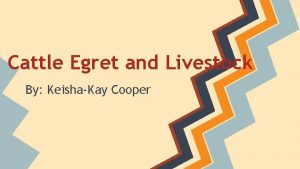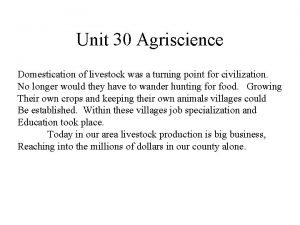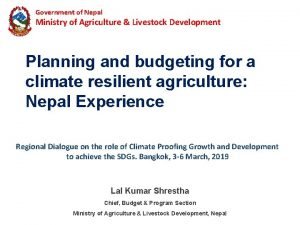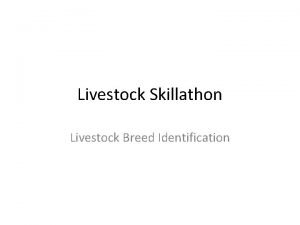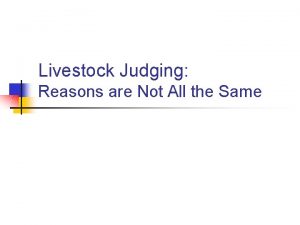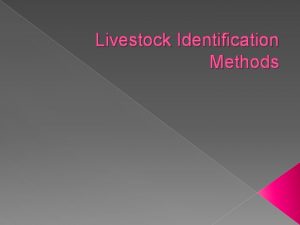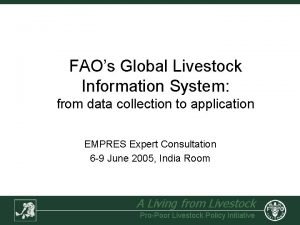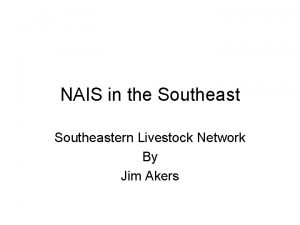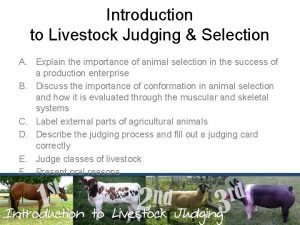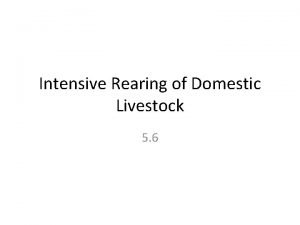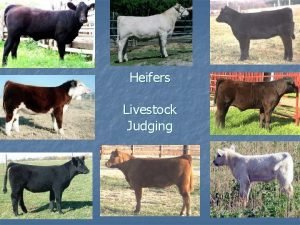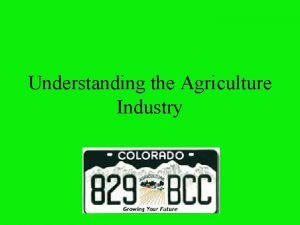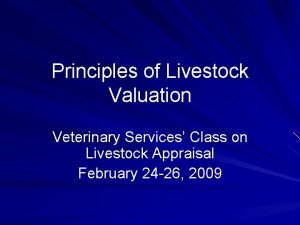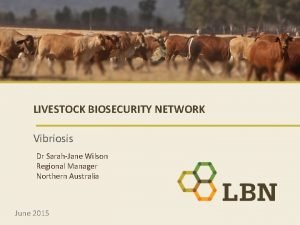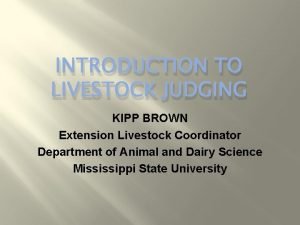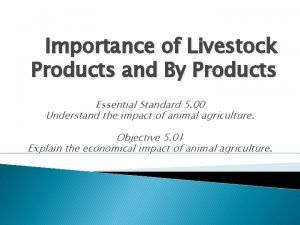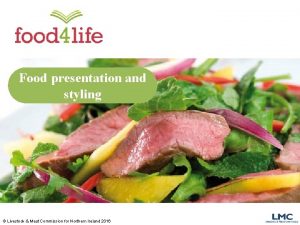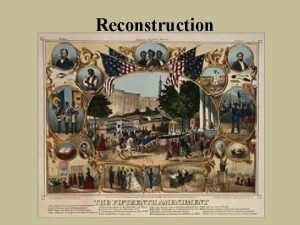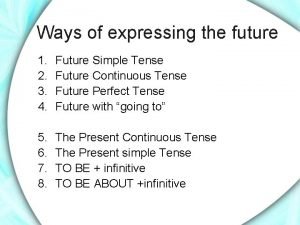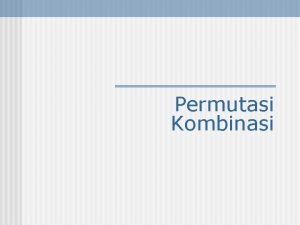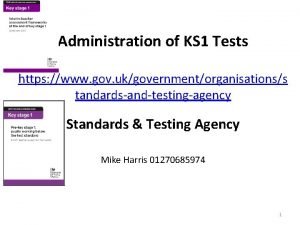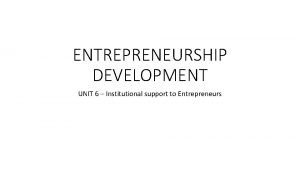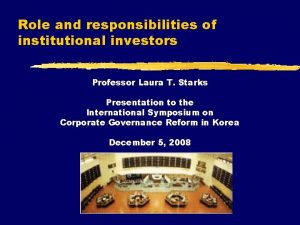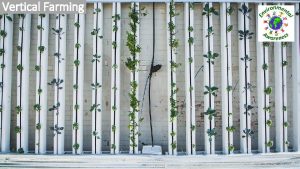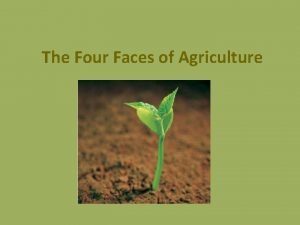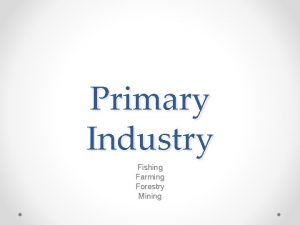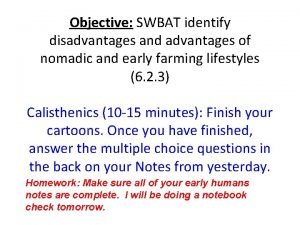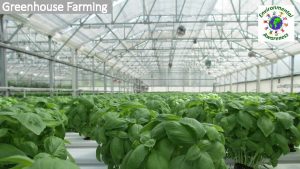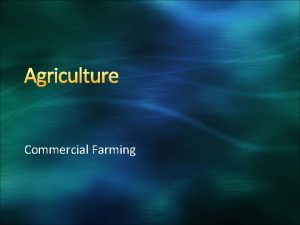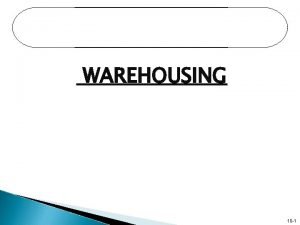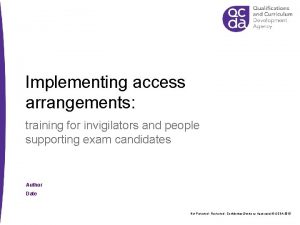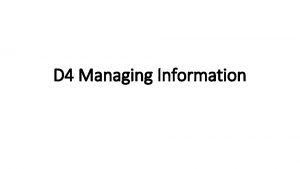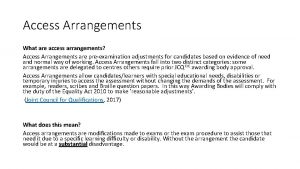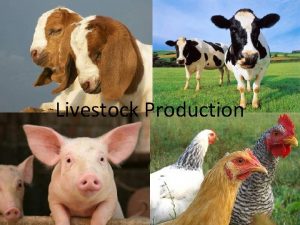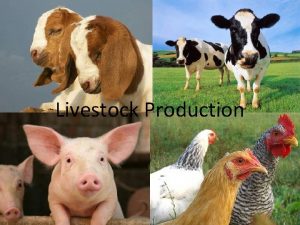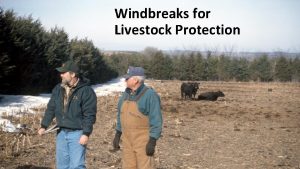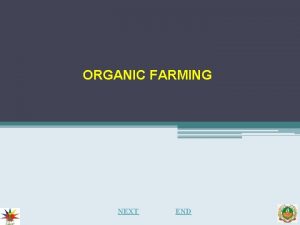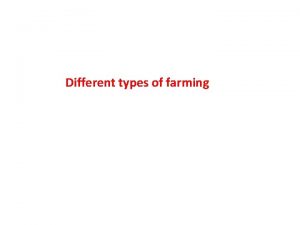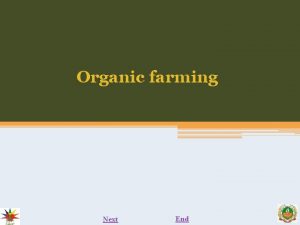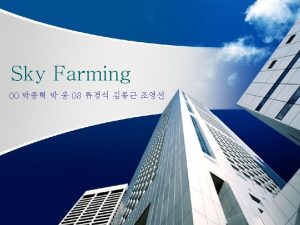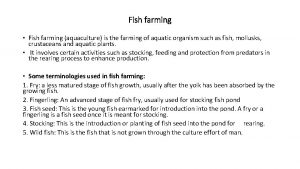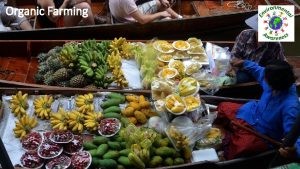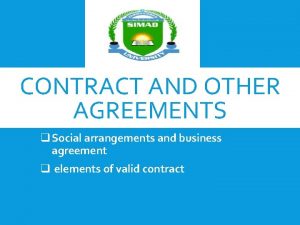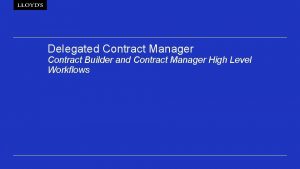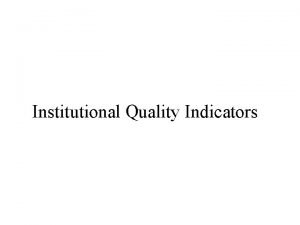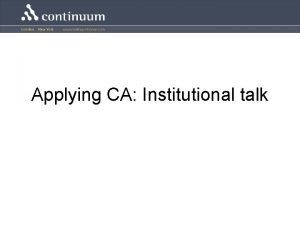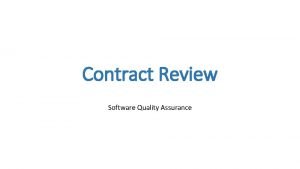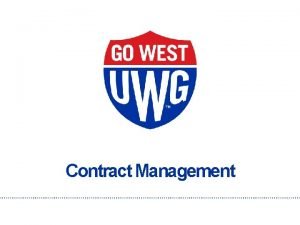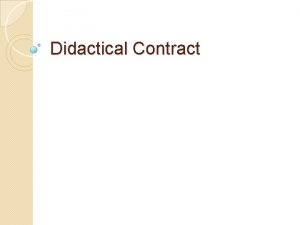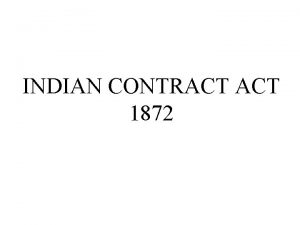Contract Farming and Other Institutional Arrangements in Livestock
















































- Slides: 48

Contract Farming and Other Institutional Arrangements in Livestock Markets in North Viet Nam: Issues and Research Methodology A. Costales (FAO PPLPI), C. Delgado (IFPRI-ILRI), M. Jabbar (IFPRI-ILRI) and M. Tiongco (IFPRI) ADBI-UNESCAP Regional Workshop on Contract Farming and Poverty Alleviation: Issues and Research Methodology UN Conference Center, Bangkok, Thailand, 9 -12 August 2004 A Living from Livestock IFPRI-ILRI JP Pro-Poor Livestock Policy Initiative

Outline • Livestock revolution in developing countries and • • • the place of smallholders and the rural poor Institutional innovations in response to changing domestic and global market environments Issues and research methodology Results from previous work on contract farming in livestock in the Philippines, Thailand India (IFPRI-FAO LEAD Livestock Industrialization Project) A Living from Livestock Pro-Poor Livestock Policy Initiative

Increases in value of food consumption for meat, milk, fish & major cereals, 1975 -1995 A Living from Livestock Pro-Poor Livestock Policy Initiative

Growth in production per capita in Developing Countries, 1975 -2001 A Living from Livestock Pro-Poor Livestock Policy Initiative

Viet Nam: Pigs and Poultry are High Growth Areas Growth in meat production Poultry meat: 8. 1% p. a. Pigmeat: 7. 3% p. a. Sources: FAOSTAT 2004; ESCB, 2004 A Living from Livestock Pro-Poor Livestock Policy Initiative

Annual Growth Rates 1970 -99 (% per annum) Low and Middle Income Developing OECD Developed Population 1. 9 0. 7 Urbanization 3. 3 0. 9 Income Per Capita 2. 2 2. 1 A Living from Livestock Pro-Poor Livestock Policy Initiative

Projected increase in per capita consumption of meat, from 1997 to 2020 A Living from Livestock Pro-Poor Livestock Policy Initiative

A Changing World for Producers • Rapid scaling-up of production • Increased demand for food safety, convenience, • • quality Rapid vertical coordination in market channels The rising importance and complexity of trade The rapidly rising stakes in disease control Increased environmental concern and enforcement A Living from Livestock Pro-Poor Livestock Policy Initiative

Scaling up: Backyard vs. Commercial hogs in S. Luzon, Philippines, 1985 -2000 Backyard hogs Commercial hogs A Living from Livestock Pro-Poor Livestock Policy Initiative

Summary 1. The demand of meat and milk will continue to expand in the developing countries 2. Growth in demand will continue to be propelled by increasing population, urbanization, and per capita incomes 3. There is increasing demand for food-safe and high quality products in both export and domestic markets A Living from Livestock Pro-Poor Livestock Policy Initiative

Summary (cont. ) 4. Smallholders are increasingly finding it harder to compete in the rapidly expanding markets 5. Individual market-entry investments to comply with production and sanitary standards are prohibitively high for small-scale producers 6. To overcome such constraints, a variety of organizational arrangements that allow small production units to benefit from various forms of collective action have emerged (e. g. , contract farming) A Living from Livestock Pro-Poor Livestock Policy Initiative

INSTITUTIONAL INNOVATIONS FOR GREATER MARKET PARTICIPATION OF SMALLHOLDERS • • • Cooperatives Producers’ associations Marketing organizations Contract growing arrangements Others A Living from Livestock IFPRI-ILRI JP Pro-Poor Livestock Policy Initiative

CONTRACT FARMING • An institution that facilitates market access for smallholders in high-value supply chains that require specialized inputs and sell to markets for specialized outputs. A Living from Livestock IFPRI-ILRI JP Pro-Poor Livestock Policy Initiative

Potential Benefits of CF to Smallholders 1. Access to capital 2. Protection against systematic loss of capital (risk sharing) 3. Access to better stock (genetics) 4. Availability of inputs, credit; quality assurance of inputs (feeds) A Living from Livestock Pro-Poor Livestock Policy Initiative

Potential Benefits of CF to Smallholders (2) 5. Absence of daily supervision and monitoring 6. Protection against loss of animal from disease mortalities (animal health programme) 7. Access to extension and vet services - better health control 8. Reliability of output market A Living from Livestock Pro-Poor Livestock Policy Initiative

Societal Benefits from Contract Farming • • • Facilitates transfer of technology Facilitates integration of smallholders into a modernizing and globalizing national economy Raising level of activity & incomes of smallholders Raising overall employment, triggering infrastructure and market development for a wider community Potential increase in access to lucrative export markets through links with transnational agribusiness companies A Living from Livestock Pro-Poor Livestock Policy Initiative

What is not yet known? Societal Impacts of CF: 1. How various terms and conditions of contracts raise incomes of, or impoverish, respectively, smallholders in the longer term; 2. Whether or not the formation of different types of organizational arrangements, based on partnership between livestock farming households and agribusiness firms, is part of an emerging trend. 3. Whether and how contract farming is associated with environmental impacts A Living from Livestock Pro-Poor Livestock Policy Initiative

Potential Pitfalls of Contract Farming • Loss of autonomy of producer • Contract terms may be stacked in favor of the • • company from windfalls of increased output prices Can lure smallholders into indebtedness that increases dependency on company May be restricted to a relatively small group of larger farmers (with a ‘bond’ to put up front); usually male gender A Living from Livestock Pro-Poor Livestock Policy Initiative

The Viet Nam Study Contract Farming & Other Institutional Arrangements A Living from Livestock IFPRI-ILRI JP Pro-Poor Livestock Policy Initiative

Goal • To facilitate forms of contract farming and other institutional market arrangements in livestock that better allow smallholder producers to flourish under rapidly changing markets. A Living from Livestock Pro-Poor Livestock Policy Initiative

Outputs 1. A comprehensive characterization of the true costs and benefits of contract farming, in contrast to other institutional and organizational schemes, in overcoming transaction costs 2. A set of policy options based on the assessment of efficiency and efficacy of contract farms, and other institutional organizations, in the promotion and facilitation of profitable livestock farming partnerships. A Living from Livestock Pro-Poor Livestock Policy Initiative

Tasks and Methodology 1. Tasks – set of specific activities for specific outputs (4) 2. Methodology – sets of procedures and techniques (5) • A Living from Livestock Pro-Poor Livestock Policy Initiative

Methodology 1. Literature review 2. Focus group interviews (qualitative information on supplier-buyer relations, quality control, volume requirements, incentives and penalties) 3. Household and farm surveys (250 hog farms; 250 poultry farms) • Different types of institutional arrangements, various • types and terms of contracts Non-contract farms (independents) A Living from Livestock Pro-Poor Livestock Policy Initiative

Methodology (2) 4. Value chains mapping - geographical distribution of chains, and distribution of margins 5. Econometric analysis of primary data • • Profit per unit output comparisons Stochastic profit frontier estimation Relative efficiency comparisons Estimation and evaluation of determinants of relative farm-specific inefficiency A Living from Livestock Pro-Poor Livestock Policy Initiative

Stochastic Profit Frontier Estimation Differences in Farm-specific Inefficiency and their Sources A Living from Livestock IFPRI-ILRI JP Pro-Poor Livestock Policy Initiative

Calculate the Dependent Variable Yi = where: PRi TVCi Qi is total profit of farm i is total revenue of farm i is total variable cost of farm i is quantity of output of farm i A Living from Livestock Pro-Poor Livestock Policy Initiative

Define a Stochastic Profit Frontier The v and u random errors are due to measurement error, etc. (v), that is distributed two-sided and inefficiency (u), that is one-sided (downwards) relative to the frontier. A Living from Livestock Pro-Poor Livestock Policy Initiative

The stochastic frontier and actual farm performance Profit per unit of Output (Y) Average relationship · · · Ideal for farm i · · · · · · · (Y*) · · · · y* · · · · · · · · · · · y · · Actual performance farm i (Yi) Stochastic frontier MLE OLS Input prices (given output price and farm fixed resources) A Living from Livestock Pro-Poor Livestock Policy Initiative

A Translog Profit Frontier Derived from supply-side & farm subscript “i” dropped A Living from Livestock Pro-Poor Livestock Policy Initiative

A Translog Profit Frontier (cont. ) A Living from Livestock Pro-Poor Livestock Policy Initiative

A Translog Profit Frontier (cont. ) A Living from Livestock Pro-Poor Livestock Policy Initiative

Estimating the Inefficiency Effects A Living from Livestock Pro-Poor Livestock Policy Initiative

Hypothesized determinants of farm-specific inefficiency 1. Policy distortions – favoring large commercial enterprises over smallholders • Investment incentives • Importation privileges 2. Transaction costs - costs of making, monitoring and enforcing exchange agreements; often intangible (can be proxied) • Linked to market power and reputation of firm • Linked to access to assets and information • Expressed to farmer as prices received or paid per comparable unit (High TC implies lower price rec’d for output) A Living from Livestock Pro-Poor Livestock Policy Initiative

Salient Findings from Previous Studies Philippines Thailand India A Living from Livestock IFPRI-ILRI JP Pro-Poor Livestock Policy Initiative

Comparisons on Profit per kg of Output A Living from Livestock IFPRI-ILRI JP Pro-Poor Livestock Policy Initiative

Differences in output prices for hogs received: Independents vs. Contract Farmers, Phil. , 2000 A Living from Livestock Pro-Poor Livestock Policy Initiative

Comparative profit per kg: Independent vs. Contract Farms in Broiler, Philippines, 2002 Profit per kilogram (Ph. P/kg) 5. 00 4. 50 4. 05 3. 96 4. 00 3. 50 3. 00 2. 50 2. 00 1. 59 1. 07 1. 00 0. 50 0. 00 Independent Contract Smallholder Independent Contract Large-Scale Source: UPLB, FAO-IFPRI Livestock Industrialization Study A Living from Livestock Pro-Poor Livestock Policy Initiative

Broiler: Independents, and Price vs. Fee Contracts, Thailand, 2002 Average profit per kg (Baht/kg) (Profit per kg) 3 2. 48 2. 5 2 1. 5 1 1. 51 1. 35 0. 71 0. 5 0 Forward Contract & Per-bird Wage Contract Independent Smallholder Forward Contract & Per-bird Wage Contract Independent Large-scale Broiler Farms A Living from Livestock Pro-Poor Livestock Policy Initiative

Comparative Efficiency and Sources of Relative Inefficiency A Living from Livestock IFPRI-ILRI JP Pro-Poor Livestock Policy Initiative

Comparative Efficiency of Broiler Farms: Independent vs. Contract Farms, Philippines, 2002 80 75 72 70 Efficiency (%) 60 50 40 45 33 30 20 10 0 Independent Contract SMALLHOLDER Independent Contract COMMERCIAL Source: UPLB, FAO-IFPRI Livestock Industrialization Study A Living from Livestock Pro-Poor Livestock Policy Initiative

Comparative efficiency: Contract vs. Independent Broiler Farms, India, 2002 70 66 Efficiency (%) 60 50 40 41 40 30 24 20 10 0 Independent Contract SMALLHOLDER Independent Contract LARGE-SCALE A Living from Livestock Pro-Poor Livestock Policy Initiative

Comparative efficiency in Swine: Contract vs. Independent Farms, Philippines, 2002 Source: UPLB, FAO-IFPRI Livestock Industrialization Study A Living from Livestock Pro-Poor Livestock Policy Initiative

Sources of Relative Inefficiency: Broad Findings • For small farms, can be traced to the high • transactions costs certain farms face For large farms, factors other than transactions costs determine relative efficiency A Living from Livestock Pro-Poor Livestock Policy Initiative

Broad Findings (cont. ) • The most important differences among small • farms are in access to working and fixed capital and then reliable inputs (genetics, feed , medicines) A key barrier to smallholders is lack of market access provided by low trust and reputation, translated as lower prices to them (typically 1015% lower in a low profit-margin industry) A Living from Livestock Pro-Poor Livestock Policy Initiative

Smallholders Need Collective Action • Coops and/or contract farming schemes may be • • • the only hope to keep smallholders in the game Contract farming covers a wide variety of institutional approaches in developing countries, some better some worse The balance of both political and market power between contractor and integrator (company) is crucial The key issue is governance; producer participation is essential A Living from Livestock Pro-Poor Livestock Policy Initiative

Concerns Beyond the Farm… Need to be complemented by Value. Chain Analysis A Living from Livestock IFPRI-ILRI JP Pro-Poor Livestock Policy Initiative

Events Beyond Farmers and Integrators Also Affect Scale • There are large economies of scale in marketing chains, where transactions costs also abound • Food safety concerns and demand for reliable timing and quality drives concentration of supermarkets • Cheaper to monitor safety & quality from a few larger farms--even most reliable and safe small farmer may by unattractive • Scaling-up of wholesaling probably leads to scaling up of primary producers A Living from Livestock Pro-Poor Livestock Policy Initiative

Events in the World Markets Affect the Viability of Smallholders • Disease-free certified export zones within • developing countries increase pressures for monitorable sanitary and traceability compliance by all; current technology is not scale-neutral Need to understand how the rapidly changing food safety, animal disease control, and trade policy environment in developed countries will affect developing countries (directly/indirectly) A Living from Livestock Pro-Poor Livestock Policy Initiative
 Contract assets and contract liabilities
Contract assets and contract liabilities Contingent contract and wagering agreement
Contingent contract and wagering agreement Cattle egrets and livestock
Cattle egrets and livestock Agriscience unit 30 self evaluation answers
Agriscience unit 30 self evaluation answers Ministry of agriculture and livestock development nepal
Ministry of agriculture and livestock development nepal Livestock breed identification swine assessment
Livestock breed identification swine assessment Livestock judging oral reasons
Livestock judging oral reasons Livestock judging reasons
Livestock judging reasons Livestock risk management brokers near me
Livestock risk management brokers near me Animal kingdom taxonomy chart
Animal kingdom taxonomy chart Livestock identification methods
Livestock identification methods Livestock information system
Livestock information system Parasites of livestock - vocabulary
Parasites of livestock - vocabulary Livestock network
Livestock network Livestock judging card
Livestock judging card Domestic livestock
Domestic livestock Livestock judging basics
Livestock judging basics Colorado livestock
Colorado livestock Livestock valuation methods
Livestock valuation methods Livestock biosecurity network
Livestock biosecurity network Livestock judging 101
Livestock judging 101 Goat judging terminology
Goat judging terminology Livestock breed identification swine - vocabulary
Livestock breed identification swine - vocabulary Food presentation is important
Food presentation is important Compare and contrast sharecropping and tenant farming
Compare and contrast sharecropping and tenant farming Self initiated other repair examples
Self initiated other repair examples How to do future simple
How to do future simple Permutasi string
Permutasi string Circular arrangement questions
Circular arrangement questions Assessment and reporting arrangements 2017
Assessment and reporting arrangements 2017 Institutional support to entrepreneurship development
Institutional support to entrepreneurship development Roles and importance of institutional investors
Roles and importance of institutional investors Vertical farming pros and cons
Vertical farming pros and cons Pros and cons of organic farming
Pros and cons of organic farming Farming mining and fishing are
Farming mining and fishing are Advantages and disadvantages of nomadic herding
Advantages and disadvantages of nomadic herding Pros and cons of greenhouses
Pros and cons of greenhouses Sharecropping and tenant farming venn diagram
Sharecropping and tenant farming venn diagram South military districts
South military districts Sharecropping and tenant farming venn diagram
Sharecropping and tenant farming venn diagram Commercial farming
Commercial farming Mixing in warehousing
Mixing in warehousing Floral design history
Floral design history Access arrangements training
Access arrangements training Louis xvi period floral design
Louis xvi period floral design The arrangement of events in the story
The arrangement of events in the story Arrangements for managing information between professionals
Arrangements for managing information between professionals What is seating arrangement in classroom
What is seating arrangement in classroom Switching replications design
Switching replications design


